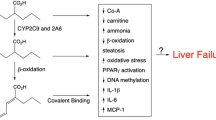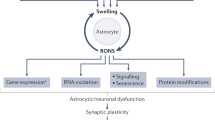Summary
Hepatic encephalopathy is a neuropsychiatric syndrome that can complicate acute and chronic liver disease. Recent research has focused on the role benzodiazepine-like substances play in the pathogenesis of this disorder. It has been proposed that potentiation of the action of the neuroinhibitory transmitter γr-aminobutyric acid (GABA) through the binding of endogenous benzodiazepine agonists to the benzodiazepine receptor binding site accounts for the clinical and biochemical features of this condition.
Increased levels of endogenous benzodiazepine-like substances have been noted in animal models of hepatic encephalopathy. In human studies, levels of these substances of up to 10 times those found in the body fluids of nonencephalopathic controls have been reported. The existence of such markedly elevated levels cannot be satisfactorily explained with reference to possible pharmaceutical or dietary origins.
Further support for the role of benzodiazepines in the mediation of hepatic encephalopathy comes from the therapeutic effect reported after administration of the benzodiazepine receptor antagonist flumazenil. Improvements in the severity of hepatic encephalopathy have been documented in rats with fulminant hepatic failure given flumazenil, although results have been inconsistent according to the dose of flumazenil used and the procedure employed to induce the encephalopathy. Transient, but distinct, improvements in the grade of hepatic encephalopathy have also been documented in several human studies. In a placebo-controlled study involving patients with mild hepatic encephalopathy, a low dose of flumazenil (0.2 mg/kg) resulted in a significant improvement in reaction time.
Research now needs to identify whether the beneficial effect of flumazenil is due to its antagonistic or inverse agonistic properties, and also to clarify the mechanisms by which the differential response to the drug in animal models of fulminant hepatic failure is mediated.
Similar content being viewed by others
References
Butterworth RF. Hepatic encephalopathy. In: Arias IM, Boyer JL, Fausto N, et al., editors. The liver: biology and pathobiology. 3rd ed. New York: Raven Press, 1994: 1193–208
Butterworth RF, Giguere JF, Michaud J, et al. ‘Ammonia’: key factor in the pathogenesis of hepatic encephalopathy. Neurochem Pathol 1987; 6: 1–12
Zieve L, Nagasawa HT. Methanethiol and derivatives in hepatic encephalopathy. J Lab Clin Med 1988; 111: 595–7
Shafer D, Jones A. Hepatic encephalopathy and the gamma-aminobutyric-acid neurotransmitter system. Lancet 1982; I: 18–20
Krnjevic K, Phillis JW. Iontophoretic studies of neurones in the mammalian cerebral cortex. J Physiol (Lond) 1963; 165: 274–304
Smialowski A. The effect of intra-hippocampal administration of gamma amino butyric acid (GABA). In: Fonnum F, editor. Amino acids as chemical transmitters. New York: Plenum Press, 1978: 1977–80
Samson Y, Bernan J, Pappata S, et al. Cerebral uptake of benzodiazepine measured by positron emission tomography in hepatic encephalopathy. N Engl J Med 1987; 316: 414–5
Oja SS, Saransaari P, Wysmyk U, et al. Loss of GABAB binding sites in the cerebral cortex of rats with acute hepatic encephalopathy. Brain Res 1993; 629: 355–7
Chiappa KH, Ropper AH. Evoked potentials in clinical medicine. N Engl J Med 1982; 306: 1140–7
Skolnick P, Moncada V, Barker JL, et al. Pentobarbital: dual actions to increase brain benzodiazepine receptor affinity. Science 1981; 211: 1448–50
Moroni F, Riggio O, Carla V, et al. Hepatic encephalopathy: lack of changes of gamma amino butyric acid content in plasma and cerebrospinal fluid. Hepatology 1987; 7: 816–20
Mullen K, Martin J, Mendelson W, et al. Could an endogenous benzodiazepine ligand contribute to hepatic encephalopathy? Lancet 1988; I: 457–9
Basile A, Harrison P, Hughes R, et al. Relationship between plasma benzodiazepine receptor ligand concentrations and severity of hepatic encephalopathy. Hepatology 1994; 1: 112–21
Rothstein J. Benzodiazepine-receptor ligands and hepatic encephalopathy: a causal relationship? Hepatology 1994; 19: 248–50
Basile A, Gammal SH, Jones EA, et al. GABAA receptor complex in an experimental model of hepatic encephalopathy: evidence for elevated levels of an endogenous benzodiazepine receptor ligand. J Neurochem 1989; 53: 1057–63
Basile A, Hughes R, Harrison P, et al. Elevated brain concentrations of 1.4-benzodiazepines in fulminant hepatic failure. N Engl J Med 1991; 7: 473–8
Basile A. The contribution of endogenous benzodiazepine receptor ligands to the pathogenesis of hepatic encephalopathy. Synapse 1991; 7: 141–50
Mullen K, Martin J, Mendelson W, et al. Evidence for the presence of a benzodiazepine receptor binding substance in cerebrospinal fluid of a rabbit model of hepatic encephalopathy. Metab Brain Dis 1989; 4: 253–60
Olasmaa M, Rothstein J, Guidotti A, et al. Endogenous benzodiazepine receptor ligands in human and animal hepatic encephalopathy. J Neurochem 1990; 55: 2015–22
Mullen K, Szauter K, Kaminsky-Russ K. ‘Endogenous’ benzodiazepine activity in body fluids of patients with hepatic encephalopathy. Lancet 1990; 336: 81–3
Wilder P, Fisch H, Schoch P, et al. Increased benzodiazepine-like activity is neither necessary nor sufficient to explain acute hepatic encephalopathy in the thioacetamide-treated rat. Hepatology 1993; 18: 1459–64
Basile A, Ostrowski NL, Gammal SH, et al. The GABAA receptor complex in hepatic encephalopathy. Autoradiographic evidence for the presence of elevated levels of a benzodiazepine receptor ligand. Neuropsychopharmacology 1990; 3(1): 61–71
Bakti G, Fisch HU, Karlaganis G, et al. Mechanism of the excessive sedative response of cirrhotics to benzodiazepines: model experiments with triazolam. Hepatology 1987; 7: 629–38
Rossle M, Deckert J, Jones EA. Autoradiographic analysis of GABA-benzodiazepine receptors in an animal model of acute hepatic encephalopathy. Hepatology 1989; 10: 143–7
Maddison JE, Dodd PR, Morrison M, et al. Plasma GABA, GABA-like activity and the brain GABA-benzodiazepine receptor complex in rats with chronic hepatic encephalopathy. Hepatology 1987; 7: 621–8
Butterworth RF, Lavoie J, Giguere JF, et al. Affinities and densities of high-affinity [3H] muscimol (GABA-A) binding sites and of central benzodiazepine receptors are unchanged in autopsied brain tissue from cirrhotic patients with hepatic encephalopathy. Hepatology 1988; 8: 1084–8
Lavoie J, Pomier-Layrargues G, Butterworth RF. Increased densities of peripheral-type benzodiazepine receptors in brain autopsy samples from cirrhotic patients with hepatic encephalopathy. Hepatology 1990; 11: 874–8
Giguere J-F, Hamel E, Butterworth RF. Increased densities of binding sites for the ‘peripheral-type benzodiazepine receptor ligand [3H]PK 11195 in rat brain following portacaval anastomosis. Brain Res 1992; 585: 295–8
Rothstein J, McKhann G, Guarneri P, et al. Cerebrospinal fluid content of diazepam binding inhibitor in chronic hepatic encephalopathy. Ann Neurol 1989; 26: 57–62
van der Rijt C, Knegt R, Schalm S, et al. Flumazenil does not improve hepatic encephalopathy associated with acute ischemic liver failure in the rabbit. Metab Brain Dis 1990; 5: 131–41
Bosman D, van den Buijs C, Haan J, et al. The effects of benzodiazepine-receptor antagonists and partial inverse agonists on acute hepatic encephalopathy in the rat. Gastroenterology 1991; 101: 772–81
Bassett M, Mullen K, Skolnick P, et al. Amelioration of hepatic encephalopathy by pharmacologic antagonism of the GABA-benzodiazepine receptor complex in a rabbit model of fulminant hepatic failure. Gastroenterology 1987; 93: 1069–76
Steindl P, Puspok A, Druml W, et al. Beneficial effect of pharmacological modulation of the GABAa-benzodiazepine receptor on hepatic encephalopathy in the rat: comparison with uremie encephalopathy. Hepatology 1991; 14: 963–8
Gammal SH, Basile AS, Geller D, et al. Reversal of the behavioral and electrophysiological abnormalities of an animal model of hepatic encephalopathy by benzodiazepine receptor ligands. Hepatology 1990; 11: 371–8
Basile A, Jones A. The involvement of benzodiazepine receptor ligands in hepatic encephalopathy. Hepatology 1994; 20: 541–4
Wilder P, Risch HU, Schlaepfer T, et al. Reply [letter]. Hepatology 1994; 20: 543
Meier R, Gyr K, Scholer A. Persisting benzodiazepine metabolites responsible for the reaction to the benzodiazepine antagonist flumazenil in patients with hepatic encephalopathy. Gastroenterology 1991; 101: 274–5
Puspok A, Herneth A, Steindl P, et al. Hepatic encephalopathy in rats with thioacetamide-induced acute liver failure is not mediated by endogenous benzodiazepines. Gastroenterology 1993; 105: 851–7
Basile A, Gammal SH, Mullen KD, et al. Differential responsiveness of cerebellar Purkinje neurons to GAB A and benzodiazepine receptor ligands in an animal model of hepatic encephalopathy. J Neurosci 1988; 8: 2414–21
Ferenci P, Grimm G, Meryn S, et al. Successful long-term treatment of portal-systemic encephalopathy by the benzodiazepine antagonist flumazenil. Gastroenterology 1989; 96: 240–3
Grimm G, Ferenci P, Katzenschlager R, et al. Improvement of hepatic encephalopathy treated with flumazenil. Lancet 1988; 17: 1392–4
Bansky G, Meier P, Riederer E, et al. Effects of the benzodiazepine receptor antagonist flumazenil in hepatic encephalopathy in humans. Gastroenterology 1989; 97: 744–50
Pomier-Layrargues G, Giguere J, Lavoie J, et al. Flumazenil in cirrhotic patients in hepatic coma: a randomised double-blind placebo-controlled crossover trial. Hepatology 1994; 19: 32–7
Butterworth RF, Wells J, Pomier-Layrargues G. Reply [letter]. Hepatology 1995; 21: 605
Gyr K, Meier R, Haussler P, et al. Evaluation of the efficacy and safety of flumazenil in the treatment of portal systemic encephalopathy: a double blind, randomised, placebo controlled multicentre study. Gut 1996; 39: 319–24
Masterton G, O’Carroll RE. Psychological assessment in liver disease. Baillieres Clin Gastroenterol 1995; 9: 791–809
Gooday R, Hayes PC, Bzeizi K, et al. Benzodiazepine receptor antagonism improves reaction time in latent hepatic encephalopathy. Psychopharmacology 1995; 119: 295–8
Tarter RE, Hegedus A, van Thiel DH, et al. Hepatic dysfunction and neuropsychological test performance in alcoholics with cirrhosis. J Stud Alcohol 1986; 46: 74–7
Arria AM, Tarter RE, Kabene MA, et al. The role of cirrhosis in memory functioning of alcoholics. Alcohol Clin Exp Res 1991; 15: 932–7
Tarter RE, van Thiel DH, Arria AM, et al. Impact of cirrhosis on the neuropsychological test performance of alcoholics. Alcohol Clin Exp Res 1988; 12: 619–21
Kapczinski F, Sherman D, Williams R, et al. Differential effects of flumazenil in alcoholics and nonalcoholic cirrhotic patients. Psychopharmacology 1995; 120: 220–6
Kapczinski F, Curran V, Przemioslo R, et al. Cognitive impairments of alcoholic cirrhotic patients: correlation with endogenous benzodiazepine receptor ligands and increased affinity of platelet receptors. J Neurol Neurosurg Psychiatry 1996; 60: 676–80
Michel H, Solere NM, Granier P, et al. Treatment of cirrhotic encephalopathy with L-dopa: a controlled clinical trial. Gastroenterology 1980; 9: 207–11
Author information
Authors and Affiliations
Corresponding author
Rights and permissions
About this article
Cite this article
Cossar, J.A., Hayes, P.C. & O’Carroll, R.E. Benzodiazepine-Like Substances and Hepatic Encephalopathy. CNS Drugs 8, 91–101 (1997). https://doi.org/10.2165/00023210-199708020-00001
Published:
Issue Date:
DOI: https://doi.org/10.2165/00023210-199708020-00001




